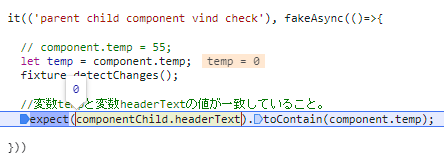はじめに
本記事は expect,it等の説明は記載しません。(記事が溢れてるから)
caseに対するテストコードの書き方を順次備忘録として追記していきます。
前提情報
fixture = TestBed.createComponent(コンポーネントクラス名);
TestBed.createComponentとは、
ComponentFixtureオブジェクトを返すメソッドらしいです。
ComponentFixtureを使用することで、
コンポーネントクラス名のインスタンス自体(要はTS)にアクセスでき、
またコンポーネントのHTML要素(DOM要素)へアクセスできるそうです。
なので、
テスト中にコンポーネントのproperty値を検証したり、
HTML要素の値を検証したりすることが可能になる。
前提
- 各componentでテストを実行する場合、
RouterTestingModuleは必ずimportsしてください。 - 同componentで使用するModuleは全てimportsしてください。
⇒errorになります。
(ngModelを使用しているが、FormsModuleをimportsしていないケース等) - toBeやtoContainといった
expect().〇〇(); の〇〇の部分をMatcherと呼ぶそう。どんな種類があるかを事前に把握する。
CASE
HTMLタグの表示確認
<p>h10s works!</p>
it('表示確認',()=>{
const pTag = fixture.debugElement.query(By.css('p'));
expect(pTag.nativeElement.textContent).toBe('h10s works!');
})
プロパティ値確認
public temperature:Number = 16;
it(('property default value check'), fakeAsync(()=>{
//対象プロパティ値 取得
let temperature = component.temperature;
//プロパティ値が16であること確認
expect(temperature).toEqual(16);
}))
ユーザ操作(onclick)でメソッドが正しく呼ばれるか確認
注意:変数定義箇所は記載していません。
<span class="mod" [class.bk-color]="isChanged">背景色が変わる</span>
<button class="buttond" (click)="onChange()">
ボタン
</button>
public onChange(){
if(this.isChanged){
return this.isChanged = false;
}else {
return this.isChanged = true;
}
}
it(('HTML button click class add'), fakeAsync(()=>{
//spanタグ 取得
let spanTag = fixture.debugElement.query(By.css('.mod')).nativeElement;
//buttonタグ 取得
let buttonTag = fixture.debugElement.query(By.css('.buttond'));
buttonTag.triggerEventHandler('click',null);
fixture.detectChanges();
tick();
//spanタグにclassが付与されてること確認
expect(spanTag.classList).toContain("bk-color");
}))
inputタグ ngModel プロパティ値更新されてるか確認
※isChangedプロパティは定義済みです。
<span class="mod" [class.bk-color]="isChanged">背景色が変わる</span>
<input class="checkinput" type="checkbox" [(ngModel)]="isChanged">
it(('HTML input click class add'), fakeAsync(()=>{
//spanタグ 取得
let spanTag = fixture.debugElement.query(By.css('.mod')).nativeElement;
//inputタグ 取得
let inputTag = fixture.debugElement.query(By.css('.checkinput')).nativeElement;
inputTag.click();
fixture.detectChanges();
//spanタグにclassが付与されてること確認
expect(spanTag.classList).toContain("bk-color");
}))
メソッドの返り値確認
spyOnはmethodをモック化します。
つまり、methodの本来のTS実装を置き換えて、テスト用のダミー動作をさせること。
public add(a:number,b:number){
return a+b;
}
public multiply(a:number,b:number){
return a*b;
}
public calculate(a:number,b:number){
return this.add(a,b)+this.multiply(a,b);
}
it('mock化',()=>{
//add methodの返り値をモック化。
spyOn(component,'add').and.returnValue(20);
//multiply methodは本来の実装処理を行う。
spyOn(component,'multiply').and.callThrough();
//calculate methodの引数をセット。
var result = component.calculate(2,3);
//add methodが呼ばれたこと確認テスト
expect(component.add).toHaveBeenCalled();
//multiply methodが呼ばれたこと確認テスト
expect(component.multiply).toHaveBeenCalled();
//呼び出した際の引数確認テスト
expect(component.multiply).toHaveBeenCalledWith(2,3);
//calculateの返り値が正しいか確認 falseになる。
//result:26になるため。
expect(result).toBe(11);
})
メソッド処理でプロパティ値が正しく変更更新されてるか確認
ngOnInit(){
this.methodTest(false);
}
public methodTest(val:boolean){
if(val){
this.add = 10;
}else {
this.add = 3;
}
}
it(('method add 3 or 10 check'), fakeAsync(()=>{
const add:Number = component.add;
spyOn(component,'methodTest');
component.ngOnInit();
expect(add).toEqual(3);
}))
追加
methodTestメソッドをonChangeメソッドから呼ぶようにします。
onChangeメソッドはHTML側のが定義されています。
public methodTest(val:boolean){
if(val){
this.add = 10;
}else {
this.add = 3;
}
}
public onChange(){
if(this.isChanged){
this.methodTest(false);
return this.isChanged = false;
}else {
this.methodTest(true);
return this.isChanged = true;
}
}
it(('userIF click methodTest check'), (()=>{
let inputTag = fixture.debugElement.query(By.css('.buttond'));
inputTag.triggerEventHandler('click',null);
const spy = spyOn(component,'methodTest');
expect(spy).toHaveBeenCalled();
expect(component.add).toEqual(10);
}))
画面Xから画面Yへ正しく遷移できてるか確認
ngOnInit(){
console.log("Acomponent");
setTimeout(()=>{
this.router.navigateByUrl('/routerComponent');
},3000)
}
let component: AComponent;
let fixture: ComponentFixture<AComponent>;
let router: Router;
beforeEach(() => {
TestBed.configureTestingModule({
declarations: [AComponent],
imports:[
RouterTestingModule,
RouterModule
]
});
fixture = TestBed.createComponent(AComponent);
component = fixture.componentInstance;
router = TestBed.inject(Router);★
fixture.detectChanges();
});
it('遷移確認', ()=>{
const spy = spyOn(router, 'navigateByUrl');
component.ngOnInit();
tick(3000);
expect(spy).toHaveBeenCalledWith('/routerComponent');
})
TestBed.inject(ライブラリ);について
※正しい認識とは少しずれるかもしれませんが、ニュアンスはあってると思います。
TestBed.injectで特定のサービス(Router,HttpClient等)のインスタンスを取得(テスト環境用の)して、
テスト環境でサービスが動作するようにします。
そして、it()の中で、 spyして使用することでモック化(ダミー化)された挙動となる。
子コンポーネントへ渡した値が正しく処理されてるか確認
■Parent側
<app-child
[headerText]="temp"
></app-child>
public temp:number = 0;
■Child側
<div class="header">
{{ headerText }}
</div>
@Input() headerText:Number | undefined;
~~~~~~省略~~~~~~
let component: ParentComponent;
let fixture: ComponentFixture<ParentComponent>;
let componentChild: ChildComponent;
~~~~~~省略~~~~~~
beforeEach(() => {
TestBed.configureTestingModule({
declarations: [
ParentComponent,
ChildComponent
],
imports:[
RouterTestingModule,
FormsModule,
HttpClientModule
]
});
fixture = TestBed.createComponent(ParentComponent);
component = fixture.componentInstance;
fixture.detectChanges();
const childDebugElement =
fixture.debugElement.query(By.directive(ChildComponent));
componentChild = childDebugElement.componentInstance;
});
it(('parent child component vind check'), fakeAsync(()=>{
// component.temp = 55;
let temp = component.temp;
fixture.detectChanges();
//変数tempと変数headerTextの値が一致していること。
expect(componentChild.headerText).toContain(component.temp);
}))
~~~~~~省略~~~~~~








